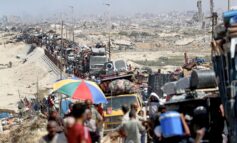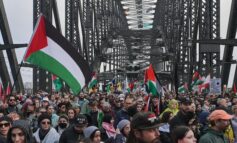EAST JERUSALEM — The U.S. consulate on Agron Street is something alien in the carefully calibrated diplomatic world of Arab-Israeli politics.
No state has its embassy to Israel in Jerusalem.
Israel insists the eastern part of the city which it annexed in the wake of the 1967 Arab-Israel War is an integral part of its “re-united” capital. The world does not recognize it as such. East Jerusalem is regarded as occupied territory.
That’s why, like other states which have diplomatic relations with Israel, the U.S. maintains two consulates in the holy city, one in west (pre-67 Israeli) Jerusalem, and one in the eastern (Palestinian) sector.
But in contrast to most, the U.S. East Jerusalem legation functions solely as a consular section. All affairs pertinent to the city’s political past, present and future are run from the consulate in West Jerusalem.
Wisely enough, that Agron Street consulate is strategically located within walking distance of the contested walled Old City and its holy places to the south-east and, to the north-west, of the official residence of the Israeli prime minister.
M.T. is new in town.
A junior diplomat at the State Department — hence the “initials only, please” — M.T. is just passing through, though eventually he hopes to be posted here. A major in oriental studies from a prestigious Ivy League university, he knows Arabic, literary and spoken, and has already served in both Lebanon and Iraq.
Meantime, he’s accumulating “the facts”, especially those relating to East Jerusalem and the changes that have taken place (or have not taken place) during the 40 plus years of Israeli occupation.
It would seem particularly important at a time when the Obama administration has made plain that East Jerusalem is part and parcel of its major new drive to advance Palestinian-Israeli peace.
“It’s not quite so easy,” says M.T. “Facts depend on who defines them, on who creates them — as you well know.”
He’s heard first-hand from both Israeli and Palestinian officials not only the “facts”, but also their conflicting, often exclusive, political perspectives on the city’s future.
But, M.T. is not your usual diplomat —maybe because he’s fresh in the job. He’s also interested in gleaning tangible facts — facts on the ground.
Refreshingly, to understand the political and diplomat wrangle over the future of East Jerusalem, he thinks he’ll benefit most by hearing from Palestinians themselves —learning what they know is good for them, rather than just hearing spokespeople tell him what they think is good for them.
And, he wants also to hear voices that are usually silent, those that go unheard in the corridors of power — the quarter million Jerusalem Palestinians caught between the perennial claims of Israel’s “eternal capital” and those of the Palestinians’ “future capita.” Caught in a time warp that’s left them largely paralyzed, forsaken, almost forgotten.
M.T. gets a lucky break: He learns of a series of bold new grassroots initiatives being taken by some Palestinians who are intent on bypassing the political impasse as the way forward to improve, through their own endeavors, the conditions of their community.
He gets an invitation to join a family for the iftar festive meal one of the last days of breaking the daily Ramadan fast.
It’s at Naim Awisat’s. M.T. has been told that the 38-year-old entrepreneur represents a burgeoning outlook among more and more Jerusalem Palestinians, a new mindset that “we must take care of our own interests because no one else has, and no one else will.”
The initiatives already include the creation for the first time under occupation of a decent public transport system in East Jerusalem. Apart from running two of the bus lines, Naim has established the first privately built clinic in East Jerusalem that’s linked to the Israeli National Health Care program.
His two-story concrete house is in the heart of Jabel Mukaber in the Sawarha conglomeration of neighborhoods (more urban villages, really) on the edge of what’s known as the Holy Basin, the most coveted area of Jerusalem. It stretches away from the Old City and its holy sites southwards to the Judean Desert and, beyond Israel’s formidable security wall, on to Bethlehem.
“Ahlan wa sahlan, You are most welcome.”
The simple plastic table on the porch is choc-a-bloc with platters of roast chicken and rice, an array of stuffed vegetables and plates of kibbeh filled with pine nuts and minced lamb. The Awisat daughters bring out white bottles of the freshly produced bitter almond juice laced with honey that’s a must for breaking the fast.
The tasty fare apart, M.T. knows very well why he’s here: Natural hospitality apart, Naim knows why he’s invited his new friend from the U.S.
Sprinkles in the night — fireworks set off from a neighbor’s porch — light up the dark streets.
Naim “hopes” his honored guest has noticed the absence of street lighting: “In a normal situation, change comes from above. But we’re not in a normal situation. No one from above even bothered to look at us here below, and they certainly didn’t act here at all.
“So, it’s up to us to change what’s usually the logical way and to turn it around — by making things happen from bottom to top. Then, there can be change and things will improve, I believe.
“Scorpions, stray dogs, mosquitoes, rats, that’s what we have here, not what we need — more school rooms, proper sewage, garbage collection. I don’t know who’s to blame, or who to blame – the mayor, the Israeli government, the prime minister?
“We, young guys here, have a different outlook on how things should be. We see things differently. I started out as a delivery man in an Israeli supermarket chain. My boss — he’s a Jew — encouraged me to apply for a tender to run the whole delivery network. That’s how I started making my money. He didn’t care whether I’m Israeli or Palestinian.”
It’s clear to M.T. that national rights are in abeyance. It’s beyond the wherewithal even of a very handy local mover and shaker.
For Naim, rather, it’s all about equal civil rights for residents of the same city: “Just like the Israelis across town, we pay what we have to, everything they demand of us — taxes, municipal bills, VAT, all the levies. What are they doing with all this money? Why don’t they do anything here?
“Imagine your kids can’t safely cross the road to go to the grocery. The roads are such a mess. A child is a child, it makes no difference — Jewish, Arab.”
M.T. nods sympathetically.
“They don’t provide the services they ought to, but I’m working and I won’t give up.”
Working in every direction.
Naim is already planning a first sports and entertainment park for Palestinians on a nearby hillside. And, he’s contemplating a more far-reaching community project still — one in which he wants to interest M.T.: To establish a sub-clinic across the security wall, in Sheikh Sa’id, a community of several thousand who were originally part of the Sawarha area but are now formally the responsibility of the Palestinian Authority.
“Surely, our families there on the other side of the wall are also entitled to subsidized health care.”
M.T. nods again. He muses whether this would be more — or less — complicated than getting support for Naim’s community projects on this side of the wall.
His car’s arrived. Time to leave: “It was a wonderful meal. We’ll be in touch, I promise,” he tells Naim.
The illuminated Golden Dome of the Rock, part of the Muslim’s Noble Sanctuary which is known to Jews as the Temple Mount, comes into view over the 16th century walls.
M.T. muses aloud to the consulate driver: “This is the heart of the matter. I just wonder whether a community project of this sort can in any way play into the big battle over sovereignty.”
Heart of the matter indeed: It was from this same place exactly nine years ago that the Palestinian intifada erupted when then opposition Israeli politician Ariel Sharon made a provocative visit to the holy mount.
And, this past Sunday, a number of Palestinians were injured and several dozen were arrested when Israeli police thwarted a stone-throwing protest by young Palestinians objecting to a group of tourists visiting the site.
This report is part of an ongoing series on the changing face of East Jerusalem after 42 years of Israeli occupation.





Leave a Reply